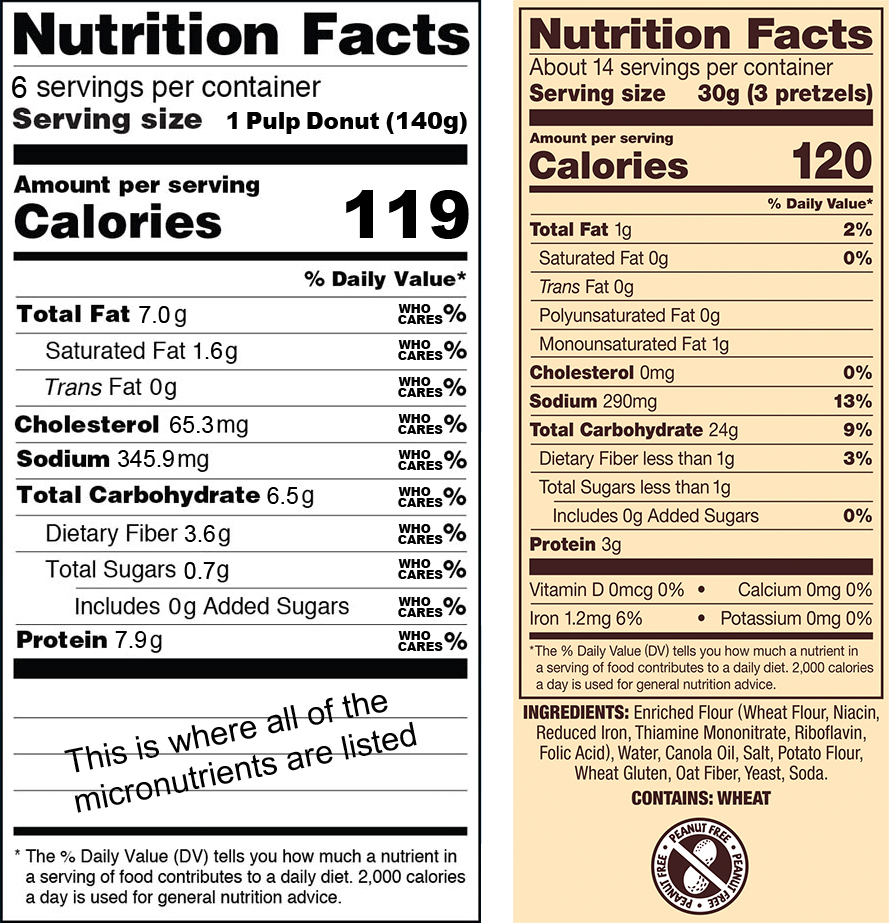

|
#4. Reading food labels Monday, July 20, 2020 In earlier blogs, we covered content-conscious shopping carts, and discussed dimension-conscious dinnerware. Next up: deciphering the code of our food labels. Every package of food has one of these:  On the left is the food label for Kratos' very own Pulp Donuts. On the right, a major pretzel company's label. If you explore your kitchen contents, you'll find that every store-bought food (excepting fresh fruit and veggies that don't have packaging) bears one of these labels. And knowing what to look for on that label will help you understand what your body is going to be ingesting (chewing whole), digesting (absorbing part), and egesting (poopin' out the rubbish). There's a lot of information on these labels, but what you're really looking at are serving size, macronutrients (fats, carbohydrates, proteins), and their summation: Calories. Notice the big C in Calories... as opposed to the little c in calories. There are a thousand calories in every Calorie. That's why Calories are often written as kcals (kilocalories, i.e., a thousand calories). What gets listed on food labels is the big C kind. One gram of protein has 4 kcals, one gram of carbohydrate has 4 kcals, and one gram of fat has 9 kcals. Collectively, these are your "energy substrates" (calories are the things that give you energy), also known as macronutrients (i.e., "macros"). It's reasonable-ish to ignore the micronutrients (vitamins and minerals), but the ingredient list does deserve some attention. It usually lives beneath the label; if it's not there, it's perched somewhere nearby. Okay, here are today's tips on label reading: Tip 1) Calories are easy to see. Big and bold. 100, 200, 500, whatever. How many total kcals do you plan to eat today? 1,800? 2,000? Quite a few. So if pretzels only have 120 kcals, that seems pretty permissive of indulgence, right? Depends. How big is a serving? That information is also listed right on top of the label. For the pretzels shown above (a national snacking staple), the answer is 3. A serving is 3 pretzels. The serving size for chips and cracker-shaped chips (e.g., Triscuits) might be double that. Nuts and granola cereals are often 1/4 cup. That's, like, two bites. A 20oz pre-packaged beverage might have 2.5 servings in it. My point: Serving size matters. Sometimes what we eat in pints is dosed (according to the label) in tablespoons. So even if the kcals appear low on the packaging, ingesting it can be likened to playing slot machines: Somehow, you blow through your entire day's budget in about 20 seconds. So Tip 1 is to keep a cynical eye on every food's serving size. Tip 2) Check the macros (fat, carbohydrate, protein). Ignore the percentages listed for each (these are based on RDAs -- Recommended Dietary Allowances -- and there are too many issues with those to unpack in a single blog), but look at the grams. The grams of fat. The grams of carbohydrate. The grams of protein. Regardless of your goal (weight loss, weight gain, heart health, diabetic interventions, etc.), macros are foundational to success. And the carbohydrate section is a particularly important one. Attainment of most goals among most people insists that you maintain moderation here. One way to moderate your carbohydrate intake is to choose higher fiber foods. Dietary fiber is listed as a subcategory of carbohydrate. It is always counted in the total, but it shouldn't be... because 0% of it is digested; 100% is egested. So if a food has 10g of carbohydrate, but 7g of fiber, there are really only 3g of usable carbs (i.e., 3g of "net carbohydrate"). The Pulp Donut above has 2.9g of net carbohydrate. Filling up on fibrous foods is a nice way to ingest away an appetite without risking the permanence of digestion. By choosing high-fiber foods, you sentence all of that gastric satisfaction to the toilet. Tip 3) Food manufacturers commonly manipulate nutrition labels in sneaky ways. Much sneakier than a serving size of 3 pretzels. When this happens, it's usually detectable in the ingredient list. For example, a sugar or fat content of "0g" does not mean "no sugar" or "no fat"; it means less than 0.5g per serving. But if it's 0.4g and you eat 10 servings, that's no longer a negligible amount. Look at the ingredient list. That's where manufacturers have to list any below-the-tiny-serving-threshold macros they sneak in. An even more important ingredient to look for: maltodextrin. On the food label, this is generally listed as fiber. But that's not how your body registers it. According to your innards, it's more sugary than table sugar. I'll explain this in deeper depth in a future blog; for now, keep your other cynical eye on the ingredient list, scanning it for the sneaky substrates (maltodextrin in particular). 
|